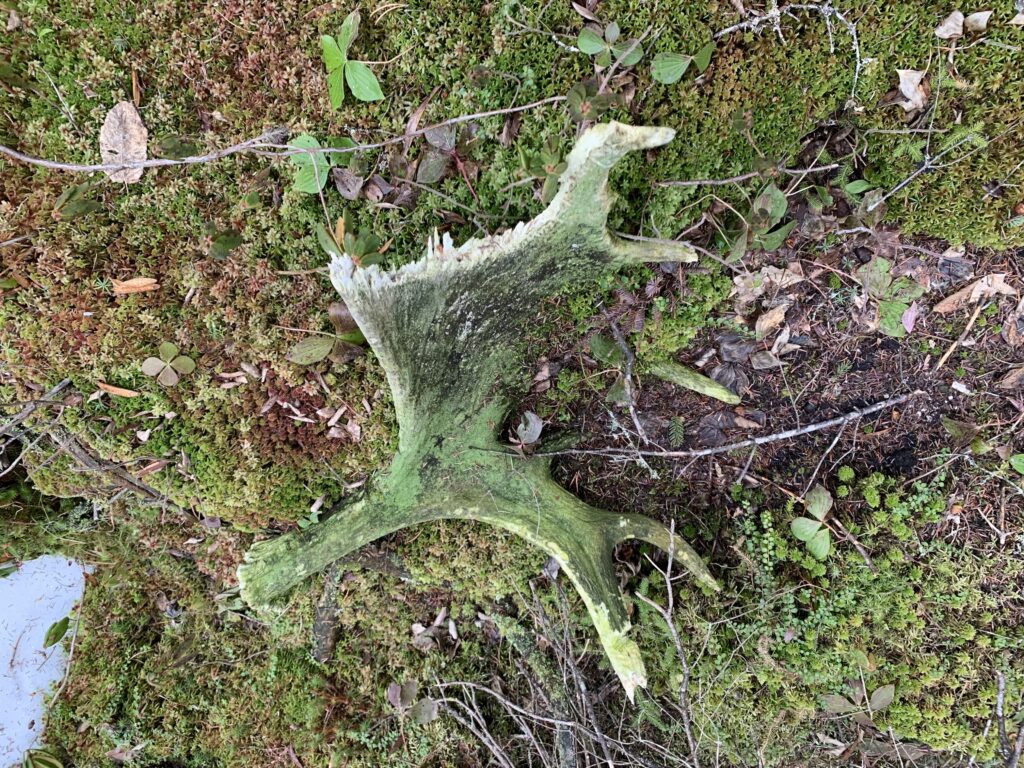One winter morning, a chocolate-brown moose antler fell like a crown from the head of a regal bull moose. The heavy antler came to rest atop a bed of crusty snow. It lay there through blizzards and thaws, with snow alternately accumulating and receding from its concave face. As the days grew longer and the sun’s rays strengthened, the sun warmed the antler and it sank through the snow, settling on a colorful, cushiony bed of sphagnum moss surrounded by Labrador tea and sheltered by tall, skinny balsam fir. The antler lay on this spongy bed like a jewel just waiting to be discovered. A hungry red squirrel, busy gathering cones one day, happened upon it and nibbled on the tine tips. A curious Canada jay perched on it for a few moments before flitting away. Other moose sniffed the antler suspiciously, but none put it back on their heads. Some of the moose were busy growing new antlers.
Time passed and the shiny brown polish the bull had dotingly given his headgear began to wear off. The sun’s intense summer rays bleached the antler’s rich brown color to a brilliant white for a while. But as fir needles gathered on the antler and stained it, and moisture from the spongy ground wicked up its sides, that color, too, began to change. The snow of many winters accumulated in the paddle and the water slowly did its work, rotting the antler. The thin, brittle top deteriorated and slowly crumbled away. The antler’s smooth, hard exterior grew chalky and flaky, and cracks formed lengthwise. Algae grew on the damp antler and changed its color again; this time to a dark forest green.
The aspen highlands that abutted the balsam swamp matured. The aspens, which had once provided 40 pounds of twigs each winter day for the antler’s hungry owner, now stood out of reach and the moose moved on to new ground miles away. The bull, once a proud warrior, now stood frail and gaunt as he entered his 13th winter. He fed hastily on dogwood and mountain maple because his internal barometer told him yet another winter storm was barreling down from the Arctic. While he braced himself for the storm, a pack of wolves cut his track and closed in on him. He stood his ground and fought valiantly, backed up against a blowdown to protect his vulnerable haunches. But the old warrior had grown weak, and this time he was unable to fend off the wolves that he had out-ran and out-dueled so many times before. And when it was all over, his bones lie fading on the forest floor as well.
Years came and went. Miles away from the wilderness swamp, new presidents took office and then left. Olympiads came. New champions were crowned. But soon their faces were just footnotes in history.
The antler lay there through it all, fading, crumbling, and rotting, gnawed on by squirrels and porcupines, but always present. Although the thinnest portions were now gone, the densest deposits of calcium and phosphorus had accumulated near the wrist-sized base. The moose had put a lot of energy into growing this antler and he had been proud of it. The antler’s resilience was testament to his sacrifice in growing it.
And then one day, many years after the moose shed his antler, a man looking to get away from his busy life was hiking through the swamp when he chanced upon the once-proud antler. He was lucky to see it. The antler’s green exterior was perfectly camouflaged against the mossy forest floor. Once a proud gem standing out from its surroundings, the ancient, weathered antler had taken on the color of its background like a chameleon until it blended harmoniously into the forest.
The man knelt beside it and pondered the improbable find. Moose hadn’t been seen in this area for years. A lot had changed since the bull dropped the antler that winter morning long ago. The winters still came every year, but they no longer had the same potency. The cold snaps were less pronounced. Although snow still fell in large amounts at times, winter thaws were more prevalent and the snow melted as quickly as it came. The landscape became more hospitable to deer, and where once only moose nibbled at the aspens, maples, dogwoods, and balsams, now deer had taken over. With the deer came more wolves. A remnant population of moose still clung to existence farther north in the harshest areas where winter still bore teeth and deer couldn’t survive the deep snow and brutal cold. But as the man turned the artifact over in his hands, he wondered if a day would come when the only sign that even those moose ever existed would be a few forgotten antlers rotting away on the forest floor.

